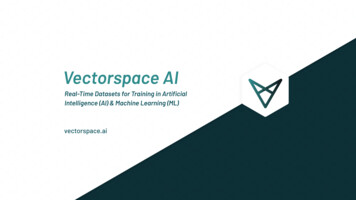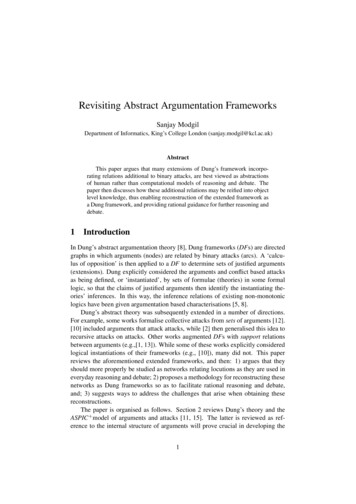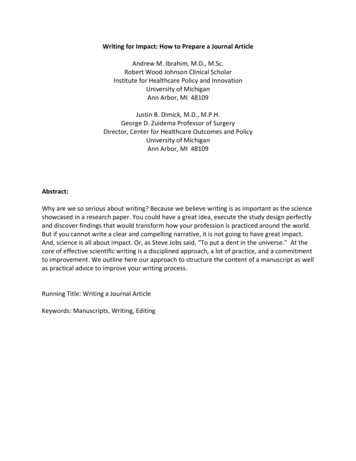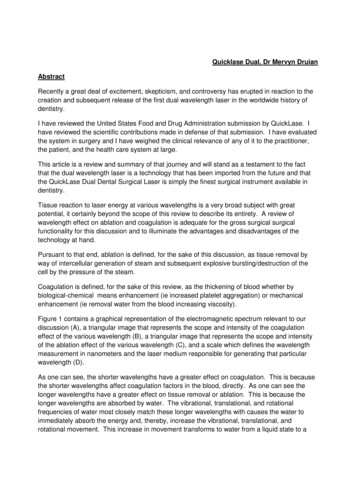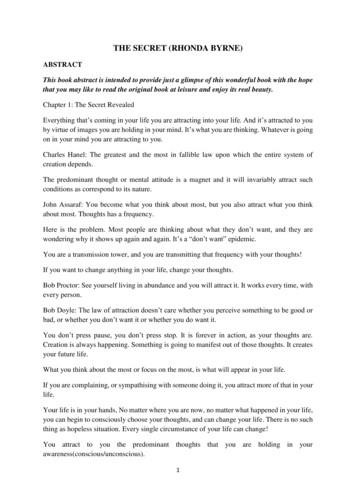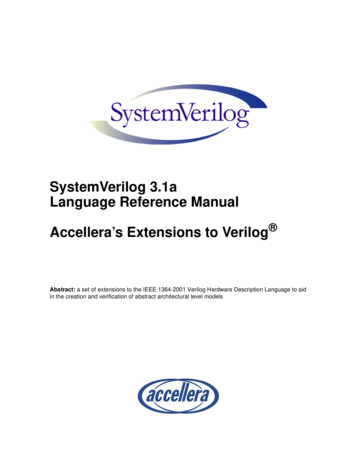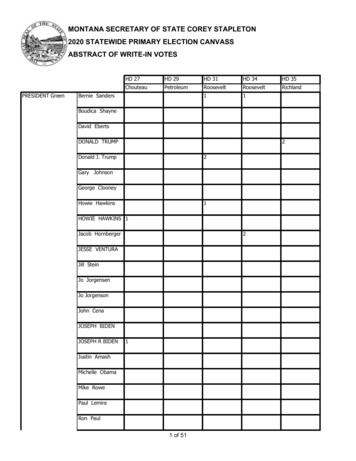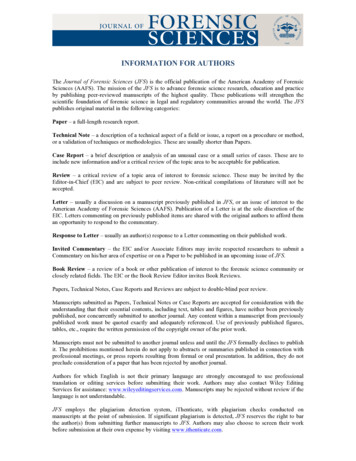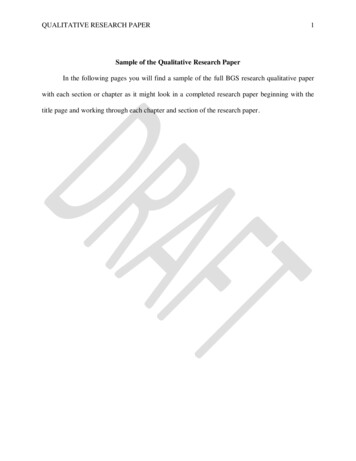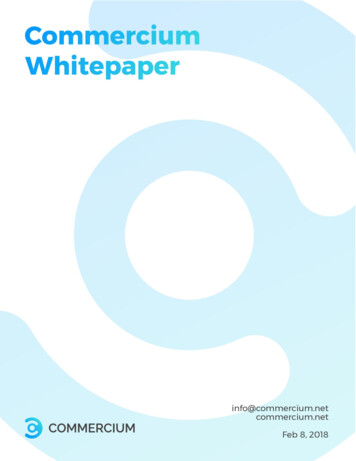
Transcription
AbstractCommercium is a dual-chain platform that ensures the most secure and efficient dataprocessing, storage and access. The Commercium Blockchain Platform will offer a customizedvirtual wallet that enables consumers and businesses to easily incorporate blockchain into theirfinancial transactions and any information tracking activities.The Commercium (i) blockchain or CMM, is an entirely new genesis of the Bitcoin codebasethat implements the ZeroCoin protocol, a form of zero-knowledge proofs delivered through RSAaccumulator encryption methods. Masternode functionality will be developed no sooner than theone hundred thousandth block, and introduced to offer additional network stability and strengthto bolster the distributed ledger. Commercium is possibly the most balanced, secure and privatecrypto-currency and implementation of distributed ledger technology to-date. The zeroknowledge proof encryption method of the ZeroCoin protocol preserves the integrity of theCommercium blockchain by ensuring auditable supply without sacrificing the ability to masktransaction data, assuring the personal privacy and security of both consumer and businessadopters. Intended for simple transactions of value, speed, privacy and security are the roots ofthe CMM blockchain.Commercium (ii) or CMMX is slated for development Q3, 2018 as an Ethereum fork andsecondary blockchain that will allow users to create, track and manage smart contracts toconduct business and transactions of value with the ability to record additional metadata asneeded for managing information, business agreements and relevant data.Definition of Commercium1plural commercia \-(ē)ə\Roman lawcommerce, traffic : commercial transaction : business intercourse; also : jus commercii(ALSO: A commercium is a traditional academic feast known at universities in most Central and Northern European countries. . Acommercium is the more formal form of the tableround, called Kneipe in German. The term is derived from French Commerce andhad been used for any sort of noisy event.)“Commercium.” Merriam-Webster, Merriam-Webster, www.merriamwebster.com/dictionary/commercium.1
IntroductionThe Commercium White Paper was created for information and discussion purposes only.Commercium and the authors of this report do not warrant the accuracy, adequacy orcompleteness of the information contained within and shall not be liable for any loss or damageresulting from the use of or reliance on any statements or information found in this report.Commercium is an open source, open community platform. The contents of this document aresubject to change.Commercium will consult with professionals in business, banking and financial regulation. Thiswhite paper will be submitted to legal and regulatory experts to seek their support in theexamination of regulatory requirements and any guidance relating to the development of theplatform. Commercium has a mission to contribute blockchain technologies, to the improvementof Domestic and International Commerce and Trade and will always strive to comply withapplicable laws and regulations. The white paper is subject to change in accordance withregulatory review and guidance, as well as input from other stakeholders and interested parties.This white paper describes the functionalities of the Commercium platform and the critical needsit can fulfill; it also provides an overview of blockchain including, distributed ledger technology,cryptocurrencies, and critical gaps in the current blockchain based payments systems, notablywith respect to ease of use, accessibility and seamless and borderless transactions of valueCommercium understands the value of cryptocurrency as an alternative payment medium forthe purchase of goods and services, whether initiated online or face to face, whether indomestic or international trade, and whether involving simple transactions, commercial contractsor letters of credit. Distributed Ledger Technology not only offers additional layers of security butalso data accuracy, completeness, timeliness and permanence, including full supply chaintransparency - all critical concerns for individuals, companies and the global economy.Consumers, entrepreneurs, investors, small and large businesses are looking for better andfaster alternatives for commercial transactions including contracts and payments. Commerciumis a dual blockchain platform which sets out to solve these issues on a large scale through acustomizable wallet interface to conduct transactions of value or create and manage contractualobligations in commerce.Commercium sets out to explore all aspects of global commerce to raise the bar of expectationsfor consumers and businesses. We hope to form a solid foundation and present a convenient,public platform to existing companies and startups, who are looking to incorporate distributedledger technologies into operations.
Table of ContentsIntroductionTable of ContentsExecutive SummaryBlockchain HistoryCryptographic Assets Vs. BlockchainMulti-Signature SecuritySmart ContractsReal World Impact Of Blockchain TechnologiesAdoption Of Cryptographic AssetsFeesEase Of UseLimitations Of CryptocurrenciesThe Commercium PlatformCommercium i (one)Ease Of UseCommercium II (two)Dual-ChainSecurity And Privacy Of UsersCommercium FundDecentralization And GovernanceUse Cases And Practical ApplicationRegulationConclusionTechnical SpecificationsRoadmapShort TermLong TermGlossary
Executive SummaryConsumers must become familiar with blockchain and distributed ledger technologies so thatorganic demand for these tools can drive integration into commerce. Functionalities that enableindividuals to pull demand for these services, will prompt corporations and businesses to meetthe needs of their customers rather than pushing unusable or complicated platforms.Commercium will work directly with the user base and community members to create intuitive,easy-to-use applications so that consumers can become fluent and confident in the blockchainbased tools they use.Forgoing the typical cryptocurrency business models of price speculation and narrow, profitfocus’, the Commercium development team is committed to working directly with businessesand regulators to create synergies between conventional models of operation and thestreamlining nature of blockchain based transactions of value. As businesses begin to embracethe platform chosen by their customers, Commercium will focus on creating practical andenduring commercial applications of its network and tools.Commercium is a not-for-profit organization that imposes transparency and will operate underthe guidance and governance of a Board of Trustees to ensure that Commercium’s consumerfocused mission is upheld. Blockchain technologies development is fluid and Commercium willengage governments and regulators around the world as implementations of distributed ledgertechnologies continue to evolve. Modernizing blockchain and realizing the benefits oftechnological advancement starts with consumer level accessibility and delivering the tools thatmeet the demands of corporate and regulatory frameworks.
Blockchain HistoryBlockchain is a method of linking sets of data called ‘blocks’ using cryptography to create acontinually growing, sequential, permanent record. Each block contains a link or reference tothe previous block, transaction data and a timestamp. Blockchain is more permanent andresistant to modification than conventional accounting and data storage methods. Modifying anyexisting block requires a massive amount of computer power to modify all succeeding blocks inthe chain in addition to the encryption process that creates data security as a whole.2Distributed ledgers are blockchains facilitated by peer-to-peer networks that collectively power,validate and process transactions. The permanence of distributed ledger technology versus aprivate blockchain, results from the scale of the community supporting it, entities known as“miners”. In order to modify any part of a blockchain facilitated through a distributed ledgernetwork, collusion of the majority of network participants (miners) is necessary; thereby limitingand even preventing any unauthorized or untraceable data changes.3,4 Fraud and illicit activityare far less viable in a distributed network that is public and open versus a private blockchain.Cryptographic Assets Vs. BlockchainCryptocurrencies, more aptly termed, cryptographic assets, are a digital medium of exchange thatapplies cryptography (data encryption), to execute secure transactions of value through a peer topeer network. Founded in 2009, Bitcoin was the first cryptographic asset and grand scaleapplication of distributed ledger technology. Use cases for bitcoin began with trading cardgames,5 and online poker6, but early adopters refer to it as a new form of money. In 2015,Ethereum was introduced as a new way to not only transfer value but also perform contracts.Cryptographic assets have introduced the ability to independently send and receive valuesecurely and instantly and then to have it recorded to a permanent and immutable ledger. Theoriginal cryptographic assets were an experiment that succeeded and proves that processingmonies or value, facilitating transactions and recording data through a distributed ledger is verymuch possible, reliable and secure.72vlabvideos. Blockchain symposium, YouTube, 18 Apr. 2016, www.youtube.com/watch?v ybl5UatYsGI.3Peter Evans-Greenwood, Robert Hillard, Ian Harper, Peter Williams. “Bitcoin, Blockchain & distributed ledgers: Caught betweenpromise and reality”, Deloitte, 2016, ncial Times: Crypto currencies are mirroring pre-Crash banking systems.” Financial Times, 9691.5“Mt. Gox.” Wikipedia, Wikimedia Foundation, 7 Dec. 2017, https://en.wikipedia.org/wiki/Mt. Gox.6Worstall, Tim. “Is Using Bitcoin The Way To Play Online Poker In The US?” Forbes, Forbes Magazine, 11 Jan. e-us/#51551bcf3637.7“John Wolpert talks about the timeline of blockchain.” DeveloperWorks TV, 5 June 2017, ut-the-timeline-of-blockchain/.
Multi-Signature SecurityMulti-signature is an additional layer of security in processing a transference of value. The totalnumber of signatures required to execute a transaction are predetermined upon creation of acontract or wallet and facilitates an escrow service that requires multi-party approval. Two ormore parties are required to agree upon the terms of service and outcome, all signing thetransaction to release its values to the intended parties. Multi-Signature Security is a processthat ensures delivery of goods upon payment and payment upon delivery of goods whilemaintaining the opportunity to dispute terms when deliverables are unmet.8 This is how a letterof credit currently works to secure international sales and purchases. Multi-signature wallets andsmart contracts will replace the need for letters of credit.Smart ContractsThe enforcement of a negotiation or performance of obligation using a protocol that verifies thatthe parameters of a contract are met. Smart contracts can be both self-executing and selfenforcing with the intent of offering more security and superior execution than conventionalcontract law when completing transactions and services.9 Smart contracts can reduce the time,people and monetary costs associated with performing a contractual obligation.10 Smartcontracts ensure project parameters are met before delivery of goods, services or payment.8Davenport, Ben. “What is Multi-Sig, and What Can It Do?” Coin Center, 1 Jan. 2015, what-can-it-do.9“Smart Contracts.” Investopedia.com, 18 Apr. 2017, 0Dmitry Buterin @dmitry-buterin, et al. “What Are Smart Contracts? A Beginner's Guide to Smart Contracts.” Blockgeeks, /.
Real World Impact Of Blockchain TechnologiesFinancial institutions and technology firms (Goldman Sachs, Bank of America, IBM, Microsoft,et. al)11 are in a race to provide blockchain services and technology capable of digitizing andautomating “middle man” industries and transaction processing, such as: banking, notaries,clearing houses, and freight forwarders.12 The speed, accuracy and efficiency with which ablockchain is able to catalogue data, execute transactions and manage contracts makesexploration of the new technology not just potentially lucrative but also a corporate responsibilityto stakeholders.13 Blockchain can increase efficiency adding not just permanence, but trust,cyber security and potentially enormous cost savings.14A highly speculative asset trading market with nearly 2000 cryptocurrencies and assets nowexists, similar to FOREX, stocks or commodities exchanges, and yet it remains distinct for itsinfancy and volatility alone.15 Each cryptocurrency seeks to, or claims to, apply blockchain anddistributed ledger technology in a novel manner, solving some real-world problem or filling somecritical niche. In this next phase of implementing blockchain technologies, we move from theoryto practice in managing all kinds of transactions and processes of value that we see in everydaylife. Blockchain and distributed ledger technology enable superior value chain management’ creating, tracking and exchanging value, as well as collaborative value transparency. However,as the technology has evolved, significant functionality, accessibility and ease of use gaps areemerging.Adoption Of Cryptographic AssetsCryptographic assets are not yet truly accessible and face much skepticism with novelty andcomplexity also obscuring the benefits and possibilities.16,17,18 In addition, limited walletcapabilities and user interfaces, impractical pricing, volatility and fees are barriers to the speedand scale of adoption in commerce and everyday use. These complications present a litmustest of both technical capability and practical understanding of business and economics.1911Kharif, Olga. “Big Banks Are Stocking Up on Blockchain Patents.” Bloomberg.com, 21 Dec. oming-wars.12Macheel, Tanaya. “Crypto Colonizing: B of A's Blockchain-Patent Strategy.” American Banker, 1 Feb. -b-of-as-blockchain-patent-strategy.13Kelly, Jemima, and Anjuli Davies; “European banks risk lagging Wall Street in blockchain race.” Reuters, Thomson Reuters, 19Oct. 2016, in-raceidUSKCN12J22L.14Long, Monica. “Ripple and XRP Can Cut Banks' Global Settlement Costs Up to 60 Percent.” Ripple, 18 Aug. nt/.15“Bitcoin VS Forex.” Bitcoin News, 5 Feb. 2016, Macquarie Analyst Rejects Jamie Dimon's Bitcoin 'Fraud' Critique.” CoinDesk, 28 Sept. 2017, dimons-bitcoin-fraud-critique/.17Costelloe, Kevin. “Bitcoin 'Ought to Be Outlawed,' Nobel Prize Winner Stiglitz Says.” Bloomberg.com, Bloomberg, 29 Nov. litz-says-jal10hxd.18McCrank, John, et al. “JPMorgan's Dimon says bitcoin 'is a fraud'.” Reuters, Thomson Reuters, 13 Sept. a-fraud-idUSKCN1BN2PN.19Baird, Nikki. “Blockchain and Retail: Four Opportunities.” Forbes, Forbes Magazine, 9 Aug. bf.
FeesInordinate transaction fees impede the adoption of cryptographic assets as some business maysee increased costs from making the switch. Sending a small sum of money through bitcoin isnow so costly that one must use an alternative when working in smaller amounts of money forany kind of transaction of value.20 In order for cryptographic assets (cryptocurrencies) to bewidely adopted as a standard means to conduct business, the fees cannot be so high theyimpede usability.21 Converting back to fiat incurs significant additional fees, sometimes in theneighbourhood of 10-15% or individuals must revert to the archaic models of value transactions,which are totally based on trust and contrary to the design of blockchain.Ease Of UseCryptographic asset wallets generally are not user friendly. A simple and secure user interfaceto buy and sell goods and services, or create and execute smart contracts, is difficult to find.Almost all cryptographic wallets today require some level of technical expertise andprogramming abilities. The current learning curve of digital assets inhibits mass adoption ofblockchain technologies as adopters are typically more technically educated or skilled.50 Massadoption requires a simple, secure and effective means to exchange, store, process, send andreceive value and execute contracts through one user interface as an individual or business.Limitations Of CryptocurrenciesThe adoption of blockchain and distributed ledger technologies is prohibitive due to costs andfees associated with available options and currently no service, tool, or business exists toprovide a simple yet secure user interface that resolves issues of practicality and functionality.Commercium (CMM & CMMX) seeks to eliminate this gap by providing the optionality andusability of two independent blockchains (dual-chain) delivered through a customizable walletapplication with consumers front of mind.Today, participation requires subject matter expertise that goes beyond traditional business,finance and trading realms to ensure the successful integration of cryptographic tools anddistributed ledger technologies. Removing the expert level barrier to entry will ensure thatblockchain technology and cryptocurrencies can become a common and standard means toconduct business with as an alternative medium for value transactions.22,2320Shin, Laura. “Will This Battle For The Soul Of Bitcoin Destroy It?” Forbes, Forbes Magazine, 25 Oct. 2f128fc3d3c021Ver, Roger, @rogerkver. “Full blocks cause high fees and unreliable confirmations which destroy usability. Usability drivesadoption. Adoption drives price. #BitcoinCash.” Twitter, 13 Nov. 2017, 62597699584.22Baird, Nikki. “Blockchain and Retail: Four Opportunities.” Forbes, Forbes Magazine, 9 Aug. bf.23Young,Joseph. “McAfee: Bitcoin is too complex for the average individual.” NEWSBTC, 2 Jan. too-complex-for-the-average-individual/.
Technological advancement has always been revolutionary, but true adoption and benefit tohumanity comes from functionalities that drive ease of use and accessibility. Computers,originally workstations, were adopted by the masses when a simple interface was developedand no longer required coding expertise (the first Apple and IBM personal computers). Theinternet was a massive leap forward, but the desktop browser, how we interface, drove itsadoption. E-trading in capital markets was introduced in the 90s and delivered autonomy andcost savings to retail investors. Technological advancement leads to accessibility, expandsreach, and drives productivity. It creates independence.
The Commercium PlatformCommercium is a dual-chain platform that focuses on functionality and ease of use and consistsof the creation of two utility chains that can be used in commerce and a way to execute valuetransactions and business agreements, privately and securely. The priority of the platform is tocreate an easy to use set of tools, in an application that will be known as the CommerciumWallet. Cryptographic assets and blockchains have the ability to create or improve societalefficiencies by streamlining the way value is transacted and recorded - eliminating the need forthird party facilitators. The Commercium platform accomplishes this by leveraging a customwallet and network infrastructure designed to integrate distributed ledger technology into oneseamless experience for consumers and business adopters.The Commercium blockchains will be delivered through a public distributed ledger networkwhere individuals (miners), may contribute hashing power (computing power) through a processknown as ‘mining’ in exchange for block rewards. This method uses what is called a ‘Proof ofWork’ algorithm (PoW), verifying the legitimacy of transactions and writing data to theblockchain, while simultaneously incentivizing miners and unlocking total supply of CMM.Adopters benefit from the additional data security, speed and accuracy offered by a distributedledger network through immutable and permanent records making it superior to a privateblockchain. The Commercium Platform serves as a medium to conduct commerce on aconsumer to business level as well as execute contracts and agreements in a business tobusiness capacity.Global and unrestricted, blockchain and distributed ledger technologies renew the strength andpossibilities of open source development. Individuals from all over the world have come togetherand contributed their knowledge and expertise to blockchain development while simultaneouslyraising awareness of systemic and sociological issues that span nations. While it is not asolution to every problem the world faces, distributed ledger technology is now being applied invery novel manners across various industries and facets of society. As we set out to trailblazein the industry, Commercium will contribute to the open source development of blockchaintechnologies through platforms that will allow businesses and individuals to integrate distributedledger technologies, further accelerating the rate of innovation, adoption, and the real benefits ofcost, time and efficiency savings.Commercium I (one)Commercium will be developed in two stages. Stage I (one) will consist of the creation of CMM(Commercium I), its blockchain, and a user friendly wallet interface. The wallet will facilitatepeer-to-peer transactions and is a secure place to store value. The wallet will be available forWindows, Linux, macOSX and mobile devices.The Commercium development team and community will create tools, applications and fosteruse cases and the adoption of the platform by consumers and business for integration into
mobile/online gaming, e-commerce, local business, face-to-face transactions, and more. Theteam will seek to list CMM on multiple cryptographic asset exchanges (where practical and safefor adopters) to increase accessibility and price stability through market forces.CMMCMM will function as a payment medium, and is intended for simple, real-time consumer-tobusiness (C2B) and business-to-business (B2B) transactions of goods, services and value.CMM is an entirely new genesis of the stalwart bitcoin codebase and applies the ZeroCoinprotocol, standard RSA encryption methods, and zero knowledge proofs. This codebase offersspeed and privacy in transactions of value. The ZeroCoin protocol itself ensures that supply isfully auditable and prevents counterfeiting. Furthermore, as whole, this method protectsindividual and business adopters from nefarious actors by not just simply camouflaging theirtransaction data, but masking it all together. Outside of authorized entities, this protocolprevents the use of topology and heuristic methods to identify wallet owners as is currentlypossible with many of the available cryptocurrency platforms such as Bitcoin.24Masternode functionality is slated for development no sooner than the one hundred thousandth(100,000th) block. Masternodes will bolster the strength and stability of the distributed ledgernetwork. The Commercium blockchain is the most highly functional, secure and private iterationof distributed ledger technologies to-date and its development team is dedicated to continuousimprovement and contribution to blockchain technologies that enable consumer level adoptionand application every day and in commerce.Ease Of UseA wallet is an application where owners can store CMM and CMMX off of exchanges in aprivate location in a unique and personal address generated by the wallet to use theCommercium Platform as a medium to send and receive value. The Commercium Walletapplication will be developed for the consumer with functionalities that address essential incomeand reporting, seamless transactions of value and intuitive contract creation among many otherplanned developments. Changing the experience and potential application of blockchaintechnologies for everyday users by delivering a simple and seamless application is a directive ofthe Commercium development team.Commercium WalletOver the course of Commercium development, tools for keeping records, to manage projects, tomanage supply chains, process transactions and create smart contracts will be created. Thewallet will facilitate the exchange between CMM and CMMX. Alternative cryptographic assetsand currencies may be added as their functionality and importance is realized in the evolution of24Miers, Ian, et al. “Zerocoin: Anonymous Distributed E-Cash from Bitcoin.” http://zerocoin.org/media/pdf/ZerocoinOakland.pdf ,2013.
blockchain technologies as an alternate payment medium. An easy pay system for the mobiledevice users will be created, exploring methods such as: swiping phones or creating atemporary and secure connection between peers. Commercium simplifies the user experienceproviding a one stop portal to use Commercium blockchains in commerce and businessactivities.Commercium II (two)Commercium (ii), CMMX, will begin development as the primary, CMM blockchain, is adoptedand will be created alongside the various wallet functionalities designed to integrate thissecondary CMMX blockchain. While CMM is the principle blockchain, CMMX will be focused onthe needs of businesses and provide a means and medium to facilitate and execute smartcontracts, agreements and create, store and track data for business-to-business operations.Dual-ChainTwo separate blockchains will enhance user efficiency and limit bottlenecks where an overloadof both simple transactions as well as contract execution can grind a single network to a halt. Adual-chain platform creates separation between transferences of value and executing contractor managing more complex data. Dual-Chain enables a more seamless experience foradopters, limiting the waiting times during periods of high network traffic. Dual chain can providethe utmost security and enable deeper levels of security with more efficient data processing.CMMXCMMX is an Ethereum codebase that’s principle application will be in integrating smartcontracts to the Commercium Wallet. The CMMX supply will be unlimited to meet the demandsof businesses allowing for the creation of new assets as needed. By working with regulators andlawmakers, the Commercium development team eventually seeks to make CMMX a tool andservice for converting to and from local fiat currency for its additional data capture ability.Security And Privacy Of UsersSecurity and privacy are tandem issues. The CMM codebase protects users by totallyanonymizing transaction data to protect user privacy, in and of itself offering a level of personalsecurity to consumers and businesses. As Commercium is committed to protecting a user’sprivacy the development team will continuously explore, create and implement tools, resourcesand applications and plugins that increase user security and privacy without sacrificing usabilityof the platform. However, the directive of Commercium is to work within legal and regulatoryfinancial frameworks and methods to discourage or prevent use of the platform for nefariousactivities will be explored and developed, such as: logging single transactions greater than tenthousand dollars, addresses that transact over one million dollars per month, caps ontransaction size or the requirement to use CMMX contracts to input additional metadata forlarger transactions.
Commercium FundThe Commercium Fund is designed to support a self-sustaining open source platform. Uponinitiation of the primary CMM blockchain, a onetime sponsors endowment of ten million units ofCMM will be deposited into a wallet owned by Commercium with controls in place to ensure thefunds are not misappropriated. The Commercium Fund is intended to meet the obligations ofmaintaining the infrastructure and rewarding developers of the Commercium Platform andblockchains, as explained below. Donations to the Commercium Fund will also be accepted andhelp to enhance the product offering that the Commercium team actively develops forconsumers and business users.For funds from the Commercium Fund to be released for Commercium development and/orspecial projects, until further notice the founders will be required to reach majority consensusapproving these initiatives. All internal and external proposals from contributors to Commerciumwill require a contract that outlines the specifications, goals and deliverables. Projects that donot benefit or further develop Commercium, driving to its core values of simplicity, security,accessibility, seamless integration and open source development, will be rejected.As Commercium will be an international, not for profit organiza
Abstract Commercium is a dual-chain platform that ensures the most secure and efficient data processing, storage and access. The Commercium Blockchain Platform will offer a customized virtual wallet that enables consumers a
